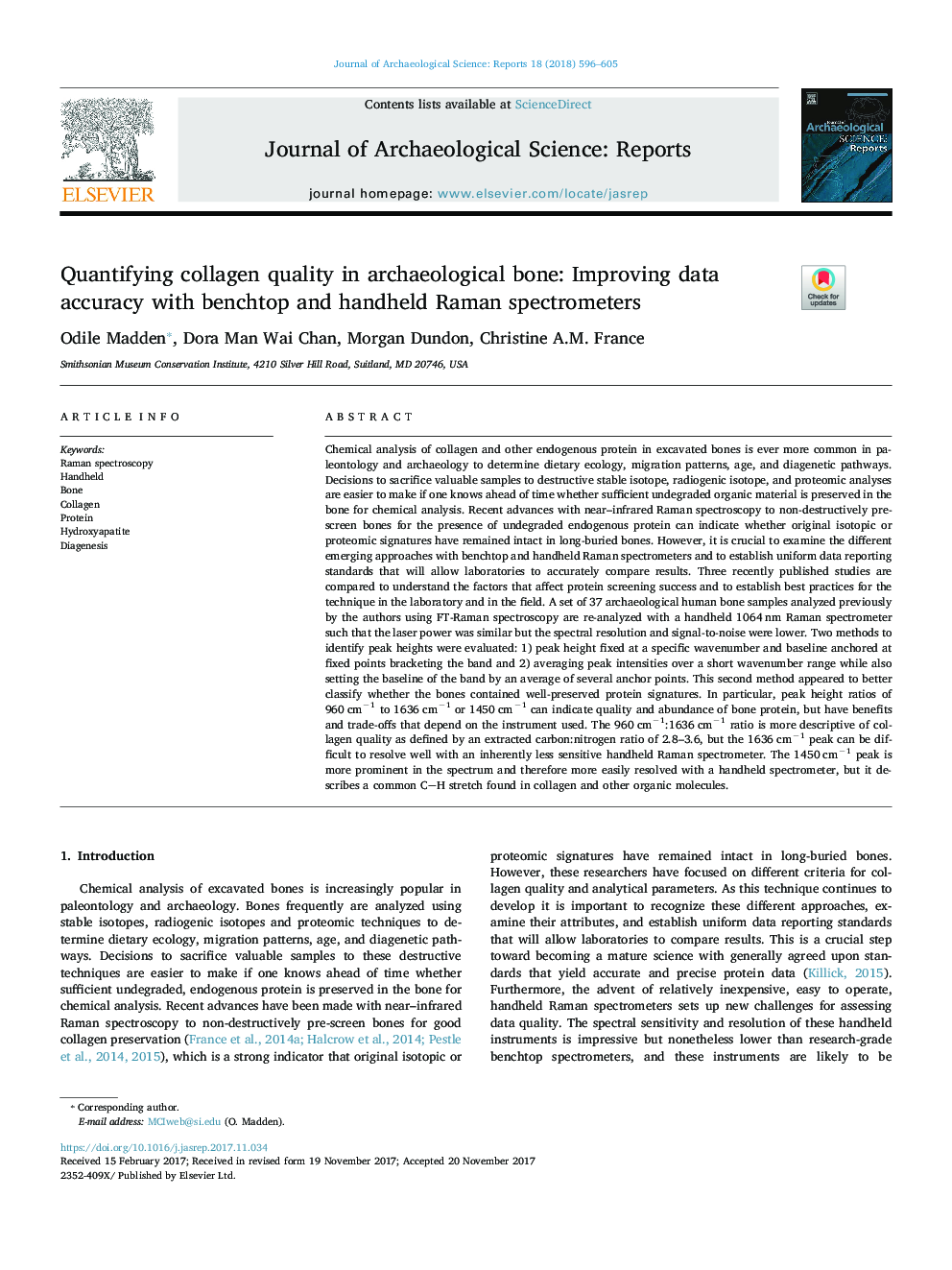| کد مقاله | کد نشریه | سال انتشار | مقاله انگلیسی | نسخه تمام متن |
|---|---|---|---|---|
| 7445115 | 1483925 | 2018 | 10 صفحه PDF | دانلود رایگان |
عنوان انگلیسی مقاله ISI
Quantifying collagen quality in archaeological bone: Improving data accuracy with benchtop and handheld Raman spectrometers
ترجمه فارسی عنوان
کیفیت کلاژن کیفیت در استخوان باستان شناسی: بهبود دقت داده ها با طیف سنج های رامان دستی و دستی
دانلود مقاله + سفارش ترجمه
دانلود مقاله ISI انگلیسی
رایگان برای ایرانیان
کلمات کلیدی
طیف سنجی رامان، دستی استخوان کلاژن، پروتئین، هیدروکسی آپاتیت، تشخیص،
موضوعات مرتبط
علوم انسانی و اجتماعی
علوم انسانی و هنر
تاریخ
چکیده انگلیسی
Chemical analysis of collagen and other endogenous protein in excavated bones is ever more common in paleontology and archaeology to determine dietary ecology, migration patterns, age, and diagenetic pathways. Decisions to sacrifice valuable samples to destructive stable isotope, radiogenic isotope, and proteomic analyses are easier to make if one knows ahead of time whether sufficient undegraded organic material is preserved in the bone for chemical analysis. Recent advances with near-infrared Raman spectroscopy to non-destructively pre-screen bones for the presence of undegraded endogenous protein can indicate whether original isotopic or proteomic signatures have remained intact in long-buried bones. However, it is crucial to examine the different emerging approaches with benchtop and handheld Raman spectrometers and to establish uniform data reporting standards that will allow laboratories to accurately compare results. Three recently published studies are compared to understand the factors that affect protein screening success and to establish best practices for the technique in the laboratory and in the field. A set of 37 archaeological human bone samples analyzed previously by the authors using FT-Raman spectroscopy are re-analyzed with a handheld 1064Â nm Raman spectrometer such that the laser power was similar but the spectral resolution and signal-to-noise were lower. Two methods to identify peak heights were evaluated: 1) peak height fixed at a specific wavenumber and baseline anchored at fixed points bracketing the band and 2) averaging peak intensities over a short wavenumber range while also setting the baseline of the band by an average of several anchor points. This second method appeared to better classify whether the bones contained well-preserved protein signatures. In particular, peak height ratios of 960Â cmâ1 to 1636Â cmâ1 or 1450Â cmâ1 can indicate quality and abundance of bone protein, but have benefits and trade-offs that depend on the instrument used. The 960Â cmâ1:1636Â cmâ1 ratio is more descriptive of collagen quality as defined by an extracted carbon:nitrogen ratio of 2.8-3.6, but the 1636Â cmâ1 peak can be difficult to resolve well with an inherently less sensitive handheld Raman spectrometer. The 1450Â cmâ1 peak is more prominent in the spectrum and therefore more easily resolved with a handheld spectrometer, but it describes a common CH stretch found in collagen and other organic molecules.
ناشر
Database: Elsevier - ScienceDirect (ساینس دایرکت)
Journal: Journal of Archaeological Science: Reports - Volume 18, April 2018, Pages 596-605
Journal: Journal of Archaeological Science: Reports - Volume 18, April 2018, Pages 596-605
نویسندگان
Odile Madden, Dora Man Wai Chan, Morgan Dundon, Christine A.M. France,
